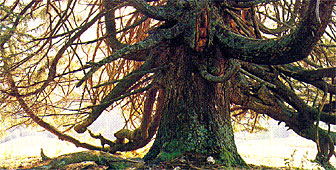Trees symbolise root of good and evil

Pay careful attention the next time you find yourself resting under a tree in a Swiss city. It may have an ancient and mythic history.
According to Germanic mythology, the supreme god Woden created the first man and woman from an ash tree and an alder.
Trees are a never-ending theme for Bernd Steiner, who has spent years documenting their history.
“What is the symbolic importance of the tree in history?” asks Steiner, explaining his long search to uproot the cultural importance of forests and trees. Together with teacher and forestry expert, Silvia Haubensak, Steiner runs the International Tree Archives (ITA) based in Winterthur.
Sacred stems
Their mission is unique: to preserve trees and forests by highlighting their cultural importance. Their goal is to systematically document the cultural history through photography and research.
Their records include ancient and historically important trees and forests in Switzerland and a dozen other countries. The oldest examples in the archives are 3,500 years old and were sacred to the Celts.
The current exhibition at the ITA is a collection of high-resolution photographs of ancient trees in Switzerland taken by Steiner’s deceased wife, who was an award-winning photographer.
Seen as a whole, the collection serves as an unusual journey across Switzerland. The pictures are also included in a new book written by Steiner, called “Baumgenossen” (tree companions).
Exploring myth
In earlier times, says Steiner, people thought in mystical ways and in analogies. “Was (the tree) inhabited by a god? Was it therefore a tree of judgement?
“…The oak tree because of its hard wood belongs naturally to gods of war – Mars, Woden, Zeuss.
“With its soft wood, the linden tree belongs to a goddess and became Christianity’s holy tree, belonging to the Virgin Mary.”
Liberty trees
“You can visit remaining ‘trees of liberty’, which were planted when Napoleon came to Switzerland,” explains Haubensak. “They were planted with little flags on the branches. The tree of liberty always had to have three branches – one for Égalité, one for Liberté and one for Fraternité.”
One tree of liberty worth visiting is in the quaint village of Ellikon on the Thur River in canton Zurich. Another is a plane tree which spreads its branches over the shore in the Lake Geneva village of Cully. It is 30 metres high and has a circumference of 600 centimetres. A plaque says it was planted in 1798, the year of Napoleon’s arrival in Switzerland.
“We have the tree in paradise. We have the tree of knowledge, the tree of life and the tree of death,” says Steiner. “And all these images pre-date Christianity. They come from the cultures of the ancient Egyptians, Greeks, Babylonians, Celts and Germans.”
Tree of justice
He explains that it was common up until the 18th century for courts of law to pass judgement under ‘trees of judgement’. It was believed these trees were possessed by gods, and therefore, the gods decided the fate of the defendants, speaking through the court.
“The tree of justice was often an oak or linden. The Greeks used plane trees, the French elms,” he says.
The monastery of Disentis in canton Graubünden was built on a place where a judgement tree once stood. Steiner says that fact gave the monks the right to judge others.
In the old town of Lucerne, a young linden tree has been replanted in the small square where Lucerne’s medieval court used to sentence people to death.
In contrast, trees of life are found in most European churchyards. Most are evergreen trees – cypresses, firs, yews. Inside the church, chances are that the wooden alter and figures of the Virgin Mary have been carved out of wood from the linden tree.
Cinderella
As part of her work, Haubensak introduces children to the importance of trees in fairy tales. “If you think of Cinderella, there is a hazelnut tree,” she explains.
“Cinderella plants a hazelnut branch on the grave of her mother. Through that bush, she gets beautiful clothes, shoes and coaches. And the hazelnut was a very important bush for Celtic peoples. It was a bush opening to another world, so it is very interesting that this bush is planted on the grave [of Cinderella’s mother].”
The tree, Steiner says, represents the cycle of life. “It dies in the autumn and awakes again in the spring. And that is what man wishes for himself.” Rebirth.
by Dale Bechtel
The ITA
The International Tree Archives is open to the public on Fridays and Saturdays. It is located in a heritage house in Winterthur, the Villa Bidermann, which boasts 100-year-old trees in its park. Winterthur is only 15 minutes by train from Zurich airport. The archives are the best starting place for a tour of Switzerland’s historically important trees. It also includes information on the country’s ancient woods and alpine forests, which have been excluded from this article for reasons of space. The International Tree Archives do not as yet have a website, but Steiner and Haubensak can be contacted at baumarchiv@gmx.ch.

In compliance with the JTI standards
More: SWI swissinfo.ch certified by the Journalism Trust Initiative
You can find an overview of ongoing debates with our journalists here. Please join us!
If you want to start a conversation about a topic raised in this article or want to report factual errors, email us at english@swissinfo.ch.